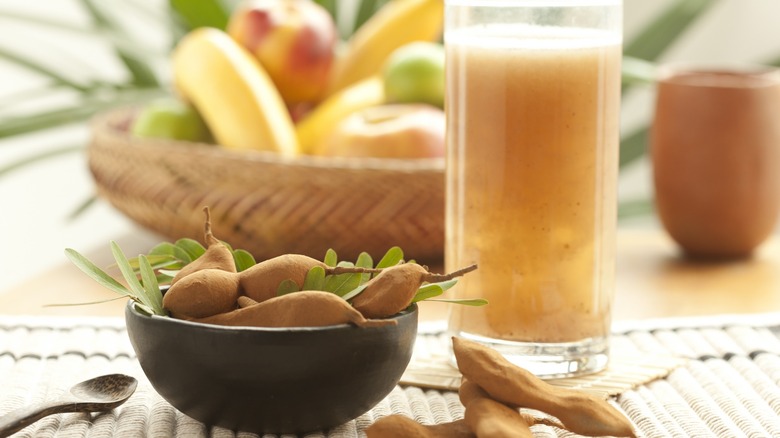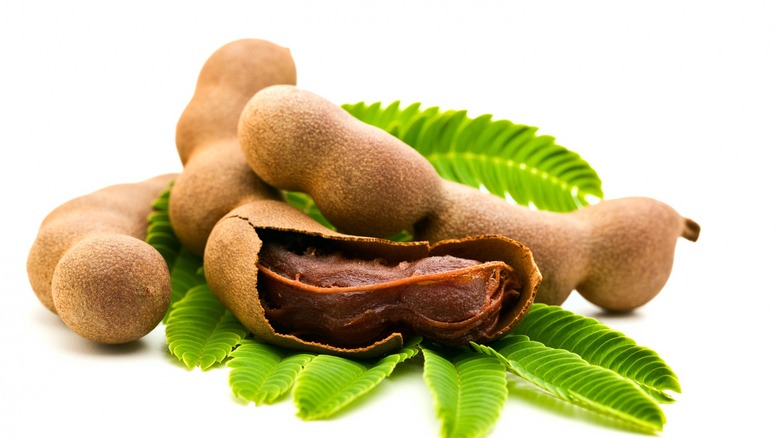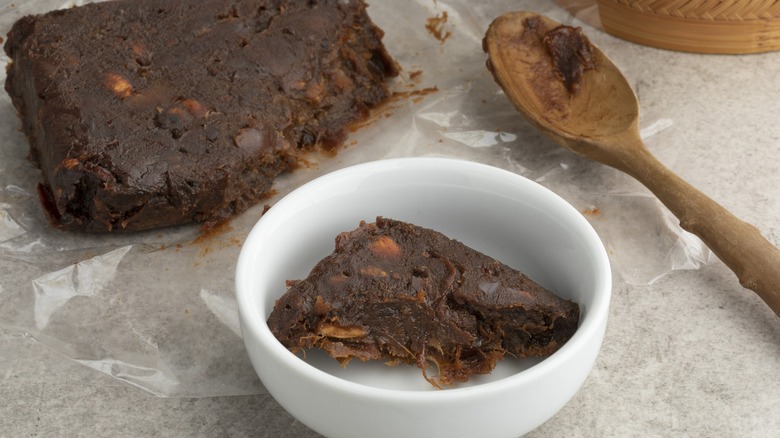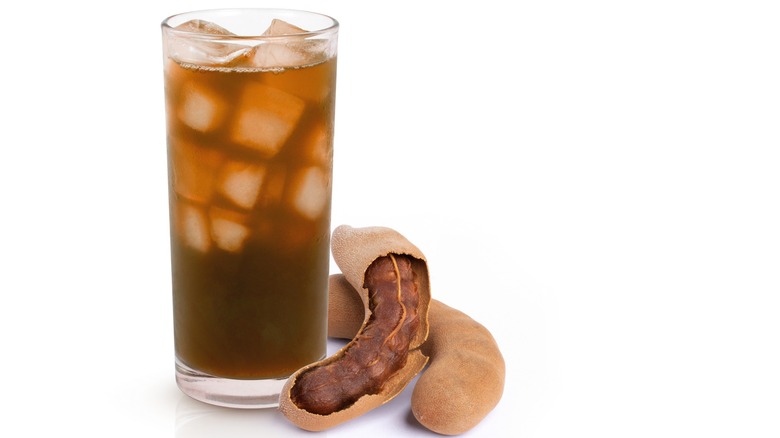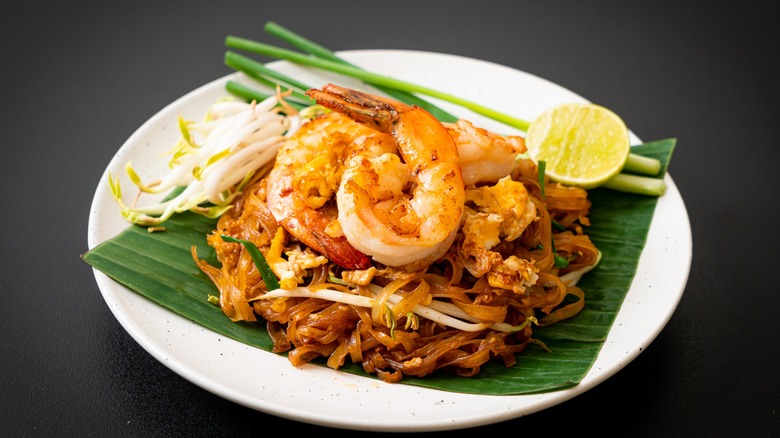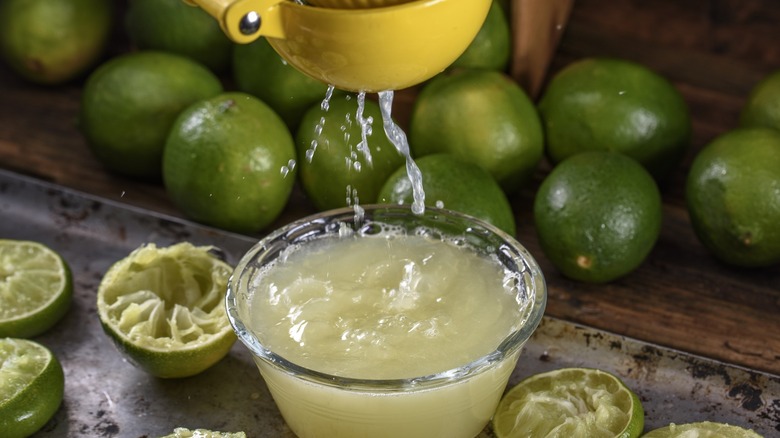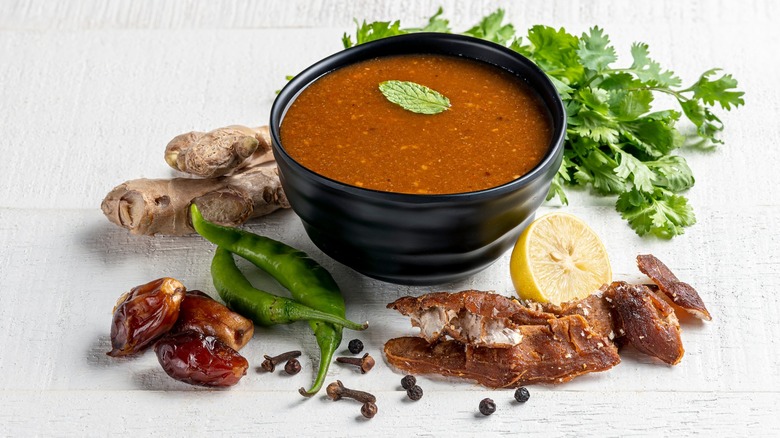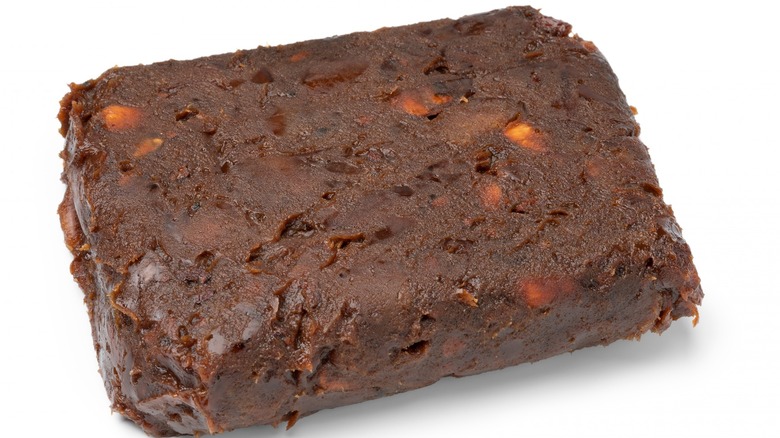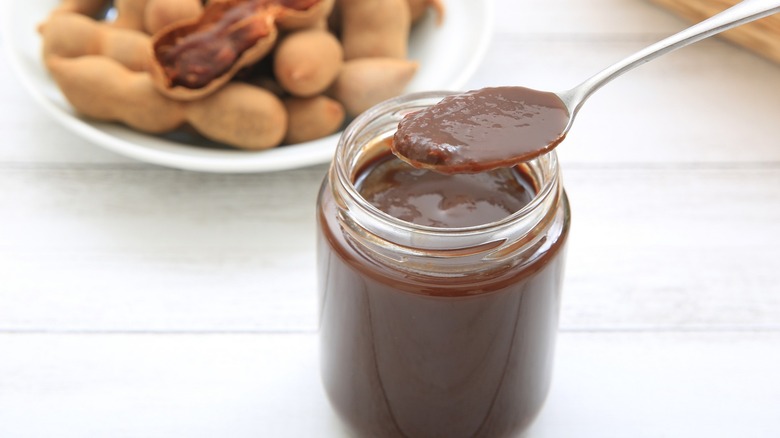What Exactly Is Tamarind?
Anyone who cooks Thai or Indian food on the regular will be aware of tamarind, the tart fruit that's an essential part of the carefully balanced sweet, sour, spicy, and salty flavor combo found in Thai cuisine. Even if you've never heard of tamarind before, we'll explain what it is, how it's made, and what it tastes like, before looking at how to cook with it and what dishes you can whip up at home using this ingredient. There's more to tamarind than just pad thai — you can use it to make everything from refreshing drinks to chutneys, stews, sauces, and more. You may even be able to find tamarind oil pressed from the fruit's seeds.
We'll also show you where to buy tamarind and dive into the different varieties you may find on sale, with the pros and cons of each and how to store each type. Keep reading, and you'll learn everything you need to know about this versatile ingredient. How will you use it in your cooking?
What is tamarind?
Tamarind, also known by its scientific name of Tamarindus indica, is the fruit of a tree native to Asia and Africa and is also found in other tropical climates. Tamarind is also extremely popular in Mexico, too, where it's used in candies. The name Tamarind comes from its Arabic name, "Tamar Hind," meaning "Indian dates." That makes a lot of sense, as when tamarind ripens, its pulp turns into a thick paste, similar in texture to date paste.
Unripe or dried tamarind pods have an extremely sour flavor. Wait for the fruit to ripen, though, and it develops a delicious sweet and sour flavor that's difficult to replicate with other ingredients. Tamarind is used in curries, chutneys, pickles, and stews, as well as soups, and as a key ingredient in the sauce for pad thai. It's even found in Worcestershire sauce. However, if you've never cooked Thai or Indian food, chances are you may not have come across tamarind before — at least, not knowingly.
How is tamarind prepared?
Tamarind pods are ready when they fall from the tree, but they can also be harvested by climbing the tree and shaking it. The pulp is compacted to create blocks. These blocks usually don't have seeds but they do still contain some fibers. To use tamarind blocks, the fruit needs to be soaked, mashed, and strained. You can also find tamarind paste in a jar. This is the end result after the fruit has been prepared as above, removing the seeds and fibrous parts. This ready-to-use paste has a smooth texture, so it can be added directly to the recipes of your choice.
If you're lucky enough to find fresh tamarind pods, you can make your own paste by crushing the shell and peeling the fruit with your fingers, placing the fruit in a bowl, and covering with water to soak for half an hour. Then, you need to work out the seeds and fibers by hand before straining the resulting fruit through a sieve.
What does tamarind taste like?
It's quite hard to describe what tamarind tastes like. There's a sweetness with hints of molasses and caramel that isn't dissimilar to dates, which might be why tamarind pods are known as Indian dates. It's a complex flavor — as well as that sweetness, there's a sour hit that carries a sharp tang. It's this sourness that makes tamarind such a key ingredient in many dishes from all the way across Southern Asia, from Thai and Indonesian cuisines, to Indian and Pakistani dishes, to recipes from West Asian countries like Iran. Sure, you can substitute brown sugar and lime juice for tamarind, but it's simply not the same.
Most of the time, the fibrous pulp inside the tamarind pods isn't eaten as is, as it's not particularly pleasant. You'll generally enjoy tamarind in the form of a smooth paste or puree, so there's no texture to speak of. Its sweet and sour flavor and smooth consistency ensure it's a great addition to drinks as well as food.
How to cook with tamarind (and what to make)
Most people in the U.S. and abroad use tamarind as a key ingredient in pad thai. Thai cuisine is all about carefully balanced flavors, and tamarind gives the dish the sour part of its sweet, salty, spicy, and sour flavor profile. You only need around 1½ tablespoons of tamarind for a typical serving of pad thai sauce, so a jar will last a long time. Tamarind can also be used in curries, to make chutney or pickle, or in tamarind candies, found in many Asian grocery stores.
In Indian and Pakistani cuisine, tamarind is a key ingredient in the flavorsome chutney served with samosas. It's also vital to make sambar, a South Indian lentil and vegetable stew. Iranian cuisine makes use of tamarind in many savory recipes such as Persian tamarind fish, while in Indonesia, it's often used to create a sour, spicy, sweet broth for vegetable soup. You can also find agua de tamarindo (tamarind water) as a deliciously refreshing drink in Mexico, made with just three ingredients: Tamarind, sugar, and water. Tamarind-based drinks are also popular across South-East Asia, including cocktails and canned drinks that are shipped worldwide.
A versatile addition to many dishes, tamarind can be used anywhere you'd like a sour and sweet flavor. Try mixing it with some soy sauce for a sweet, sour, and salty salad dressing, or thinly sliced stir-fried beef. Or make a delicious tamarind orange chutney to perfectly complement spicy grilled shrimp.
What can you substitute for tamarind?
Tamarind has an unusual flavor that's quite hard to replicate. For a similar sweet and sour taste, you could use brown sugar and lime juice — or lemon juice, in a pinch. The brown sugar brings the molasses and caramel notes of tamarind to whatever dish you're making, with the citrus mimicking the familiar sharp tang. However, this will still lack the complexity of tamarind's flavor.
Balsamic vinegar may work as a substitute for tamarind, depending on the dish you're making. Balsamic has acidity alongside sweetness, giving it a similar flavor — though by no means an exact match — to tamarind. Start with just a little, though, to make certain the flavor works in your dish.
Other alternatives to tamarind include Worcestershire sauce and sugar, or ketchup. The latter can work surprisingly well in homemade pad thai if you don't have tamarind to hand. Unless the recipe you're making relies heavily on tamarind for flavor, it may be possible to just leave it out altogether if you're unable to find any.
Where to buy tamarind
If you're after the widest selection of jarred, canned, and block tamarind, we'd recommend making a trip to your local specialist Asian grocery store, if you're lucky enough to have one nearby. Don't live in a major city? These days many larger grocery stores also stock tamarind in their Asian or world foods aisle, as it's such a popular ingredient for pad thai and Thai cooking in general.
If you really can't find tamarind in your local market or store, there's always online. Sites such as Amazon often have deals on jars or blocks of tamarind paste. Being so acidic, it can last for a long time in your kitchen, easily lasting for months if kept somewhere cool and dry. This means it's a worthwhile investment if you're going to be dabbling in South or Southeast Asian food in the near future. The one downside to buying tamarind online? It's usually more expensive than in stores, and you may need to buy in bulk.
Nutritional information about tamarind
You might have used tamarind in your cooking before, but did you know about its health benefits? It turns out, it's actually a pretty healthy fruit! A cup of tamarind pulp (around 120 grams) packs 26% of your daily value (DV) of magnesium, 19% of your DV of iron, 43% of your DV of Vitamin B1 (thiamin), and 16% of your DV of potassium. It's worth bearing in mind, though, that most recipes won't require you to use this much tamarind at a time!
In beverages, tamarind has traditionally been used to ease constipation and diarrhea, as well as aiding digestion. The fruit also contains polyphenols, which have antioxidant and anti-inflammatory properties. One study published in the Asian Pacific Journal of Tropical Biomedicine notes that this may protect against diabetes, cancer, and heart disease. Tamarind extract's natural compounds also have antimicrobial effects, and the fruit may have antifungal, antibacterial, and antiviral activity. The fruit and leaves have even been used in the treatment of malaria. In addition, tamarind may potentially help protect the liver and prevent fatty liver disease. This is thanks to the presence of antioxidants known as procyanidins, which can improve liver health and help soothe nausea and indigestion.
Side effects of eating tamarind
Though there are several health benefits associated with eating tamarind, some less pleasant side effects could occur if you eat too much of the fruit. Tamarind can act as a laxative when consumed in excess, potentially causing stomach pains and severe diarrhea which can lead to dehydration. If you've been diagnosed with diabetes, you should also take care when consuming tamarind, or avoid it altogether. That's because it can lower blood sugar levels, which may be dangerous for diabetics.
Tamarind is also a legume, part of a group of foods that includes nuts and pulses, including fava beans, edamame, garbanzo beans, lentils, and peanuts, among other foods. This means that anyone with food allergies to legumes should speak to a health professional before consuming tamarind, or avoid it.
That said, tamarind's many health benefits, including its anti-inflammatory effects, benefits for heart health, and ability to aid digestion, generally outweigh any less-than-pleasant side effects. Barring those with legume allergies, most people should be able to consume tamarind in moderation without problems.
Varieties of tamarind: Which type should you buy?
Tamarind is available to buy in a variety of different forms, and the type you buy comes down to personal preference. In some specialist Asian grocery stores, you can find fresh fruit pods on sale, though these do require a lot of preparation to turn into tamarind paste.
You can also buy blocks of tamarind, which contain the seeds and pulp. Like fresh fruit, these require soaking, mashing, and straining to turn them into a puree or paste suitable for use in your cooking. This can be pretty messy and time-consuming to prepare. For those who use tamarind regularly, tamarind paste, sold in cans and jars, is far more convenient. However, it doesn't last as long as blocks of tamarind, so if you only use this ingredient occasionally in your cooking, it's probably best to stick with the blocks. Buying canned or jarred paste is usually more expensive, too.
Finally, you can buy tamarind concentrate and tamarind powder in most specialist Asian grocery stores. Despite the name, tamarind concentrate is more watered-down than the paste, so you'll need to use more, which may work out more expensive in the long run.
How to store tamarind
How you store tamarind will depend on the type that you buy. Unopened, a block of tamarind can be stored in a cool, dark, dry place like your cupboard or pantry and potentially kept indefinitely, provided moisture doesn't get in. Once opened, it should be sealed in an airtight container and can still be kept in your pantry or cupboard for months, as long as it's cool and dry.
You can store jars and cans of tamarind paste or puree in your cupboard or pantry, as long as they haven't been opened. Once you open them, they should be refrigerated. Stored in your fridge, they'll keep for several months. As with jams and preserves, just make sure to check for mold before using them in your cooking! You may notice the top of the paste becoming discolored due to oxidation, but it's generally still safe to eat. Note that homemade tamarind paste won't keep as long as the store-bought variety. Tamarind paste, either homemade or shop-bought, can also be stored in your freezer to prolong its shelf life and make it convenient to use — you can store it in ice cube trays and pop a frozen cube directly into your cooking, with no need for thawing.
